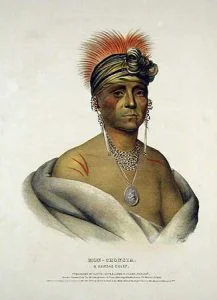
The Kansas town erected at the mouth of the Big Blue was established after Bourgmont’s visit to the tribes at the mouth of Independence Creek. The exact date can not now be fixed. It was probably about 1780. Lewis and Clark found their abandoned villages on the Missouri and their towns were then on the Kansas. One town was twenty leagues up this river, and the other twice that distance. The entry runs to this effect: This river (the Kansas) receives its name from a nation which dwells at this time on its banks, and has two villages one about twenty leagues, and the other forty leagues up. The location of the first village is not now certainly known, but it must have been near the present site of Topeka. There was a Kansas town immediately west of the present North Topeka at different periods after the expedition of Lewis and Clark. The upper village was at the mouth of the Big Blue. It was in Pottawatomie County between the Blue and the Kansas rivers, on a neck of land formed by the parallel courses of the two streams, and about two miles east of Manhattan. This became the sole residence of the Kansa before 1806, for in that year Captains Lewis and Clark, Doctor Sibley and Mr. Dunbar, made an exploration to discover the conditions of the Western Indians. The lower village had been abandoned and the inference is that the inhabitants had moved to the town at the mouth of the Blue. The entry on this subject is Eighty-leagues up the Kansas River, on the north side. And the report says they all lived in this one village. They furnished the traders with the skins of deer, beaver, black bear, otter (a few), and raccoon (a few). Also buffalo robes and buffalo tallow. This fur product brought the tribe about five thousand dollars annually in goods sent up from St. Louis. The general remarks on the Kansas made at that time by the explorers Lewis, Clark and others are of interest.
The limits of the country they claim is not known. The country in which they reside, and from thence to the Missouri, is a delightful one, and generally well watered and covered with excellent timber: they hunt on the upper part of Kanzas and Arkanzas rivers: Their trade may be expected to increase with proper management. At present they are a dissolute, lawless banditti; frequently plunder their traders, and commit depredations on persons ascending and descending the Missouri river: population rather increasing. These people, as well as the Great and Little Osages, are stationary, at their villages, from about the 15th of March to the 15th of May, and again from the 15th of August to the 15th of October: the balance of the year is appropriated to hunting. They cultivate corn, &c.

The town at the mouth of the Blue was partly depopulated about 1827. In that year an Agency for the Kansas Indians was established on Allotment No. 23, to Kansas half-breeds, on the north bank of the Kansas River, in what is now Jefferson County. At least, it was intended to build the Agency on that Allotment. It was in fact so near the east line of the tract that some of the buildings were on section 33, township 11, range 19, and on section 4, township 12, range 19, most of them on section 4, as was determined when the state was surveyed. This town was south of the station of Williamstown, on the Union Pacific Railway. There was a blacksmith and a farmer appointed for the Indians of the Agency, and these lived there. The farmer was Col. Daniel Morgan Boone, son of the great pioneer. Napoleon Boone, son of Col. D. M. Boone, was born there August 22, 1828, supposed to have been the first white child born in what was to become Kansas. The chief, Plume Blanche, White Plume, or Wampawara, was at the head of the village. Frederick Chouteau was the Indian trader. He had his trading-house on the south side of the river, on Horseshoe Lake, now Lakeview. It was at this Agency that Captain Bonneville crossed the Kansas River on his journey to the Rocky Mountains (1832). Marston G. Clark was U. S. Sub-Indian Agent there. The Captain spent the night with Chief White Plume, whom he found living in a substantial stone home, which had been erected for him by the Government. It is scarcely probable that all the Kansas Indians were gathered about this Agency. No doubt there were other villages up the Kansas River at that time. Some of the annuity payments provided for in the treaty when the great cession was concluded were made at this agency. The first was made at a trading-house near the mouth of the Kansas River, in what is now Wyandotte County. White Plume discovered in some way that his residence was over the line on the Delaware lands. While there would never have been any objection to this mistake or oversight of the white men who located the Agency buildings, White Plume was too proud to live on the land of another tribe. He abandoned his house and moved up the Kansas River. His house stood northwest of the Agency, and north of where the railroad station of Williamstown was located. Long before he moved his house had become uninhabitable, most of the woodwork having been torn out and used for fuel. It was alive with vermin.

